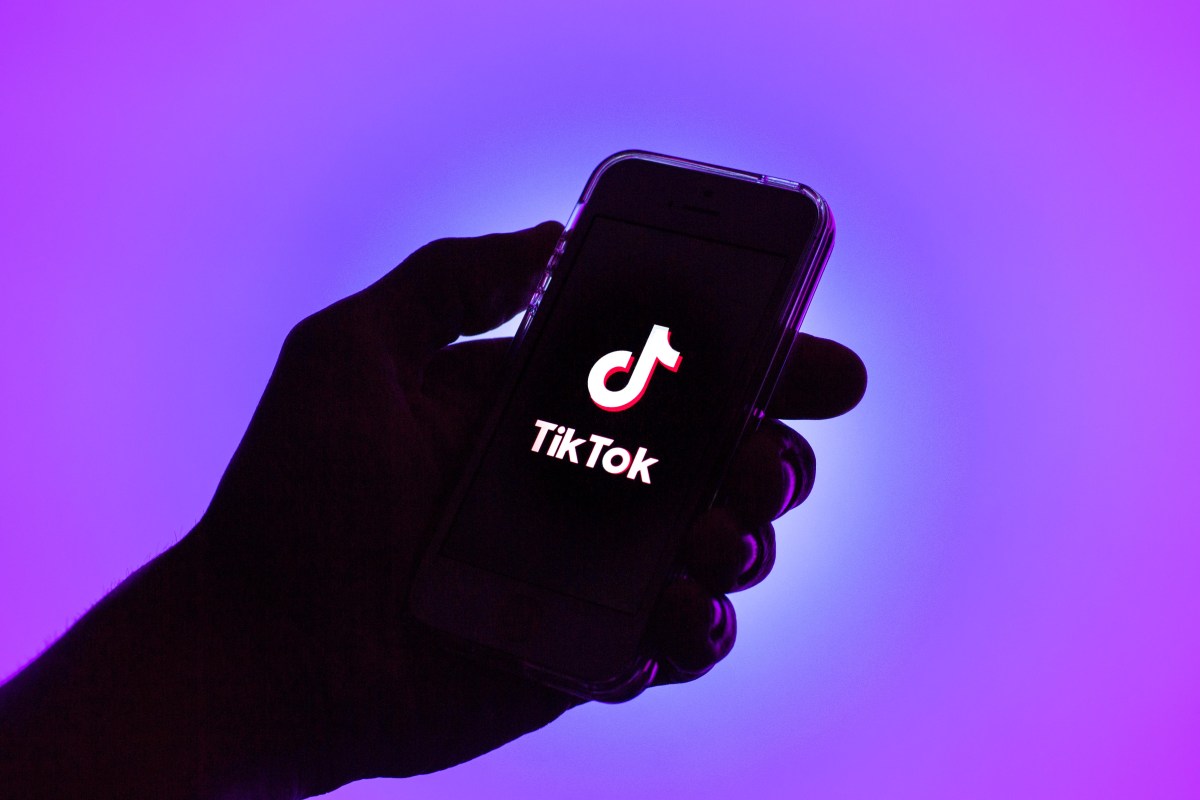
The Motorola Edge+ (2023)—Edge 40 Pro in some markets—arrived in our office and looks like a real flagship on paper: Snapdragon 8 Gen 2, a strong triple camera, and a 165 Hz OLED display suggest a great Android smartphone. You can find out how good our first impression really is in our hands-on.
Good
- Good haptics
- Good display
- IP68 certification
- Fast processor
- Good update guarantee
- Moto My UX and Ready For
- 125-watt TurboPower power adapter
Bad
- Camera is not flagship-level
- Only one memory configuration
- No headphone jack
- No microSD support
Motorola Edge+ (2023) release date and price
The Motorola Edge 40 Pro is now available in Europe, where you can choose between the two colors Interstellar Black and Lunar Blue. Unfortunately, the device is only available in one storage configuration in the market, although the Chinese Lenovo subsidiary offers two variants. While you can also opt for 512 GB in China, it is “only” 12 GB LPDDR5X RAM and non-expandable UFS 4.0 program storage with a capacity of 256 GB for now.
And although I personally consider this size to be completely sufficient, I have included the lack of microSD card support as a negative point of criticism in the overall rating. But feel free to write us your opinion about this point of criticism for the final review in the comments!
Motorola hasn’t confirmed the device launch in the US—where it is expected to be called Motorola Edge+ (2023)—nor its available configurations, so keep in mind that we reviewed the Euro-spec model and things can change before a US release.
A look at the technical specs tells us that the Motorola Edge+ 2023 is a strong contender for the affordable flagships category. There are powerful competitors like the Samsung Galaxy S23, the Apple iPhone 14, and the Xiaomi 13 to beat. So let’s find out together whether Moto can keep up with the prominent competition as the cheapest provider with a price of 899.99 Euros (approximately $980).
Design & Display
The Motorola Edge+ (2023) looks classy with its glass curved on all sides. Like the front, the back is also protected by Corning Gorilla Glass Victus and also houses an eye-catching camera island. The display’s high refresh rate is particularly striking: 165 Hz is quite a claim and otherwise only found in gaming smartphones.
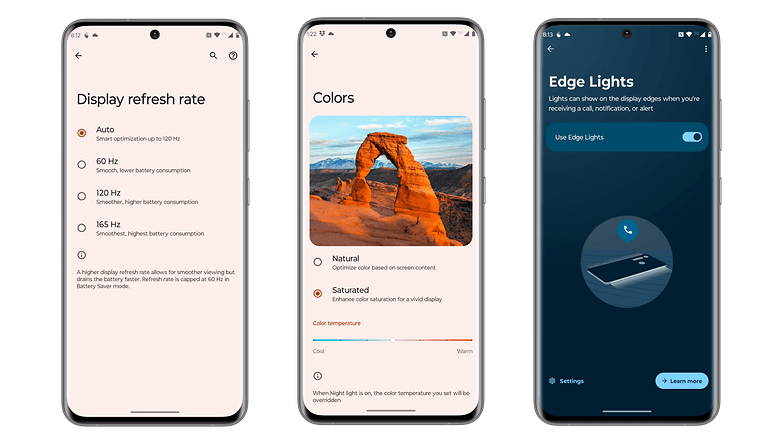
The 6.67-inch OLED display otherwise offers a rather standard market resolution of 2400 x 1080 px, which is a bit surprising since the competition offers more pixels on the screen. Whether this is really necessary or rather counterproductive will be discussed in our detailed review. At least at first glance, the panel convinces with its exceptional viewing angle stability.
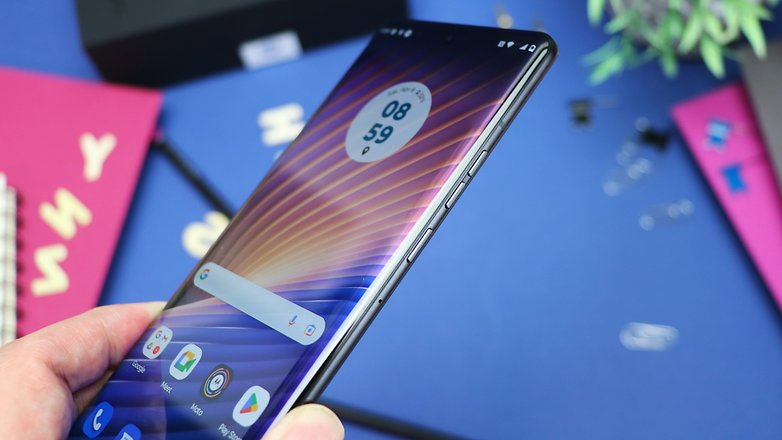
The curved edges might probably not please everyone, but then again, everyone will surely agree on the support for Dolby Vision and HDR10+. Speaking of Dolby: Dolby Atmos is also supported, and there are also two speakers for stereo sound. The sound is correspondingly good due to the lack of space.
The camera area on the back is striking and combines the three sensors in one island. The selfie camera is located in the central punch hole in the front. At least on the spec sheet, the company makes a good impression with a proud 60 MP. Motorola’s Edge+ (2023) is IP68-certified, weighs 199 grams, and measures 161.16 x 74 x 8.59 mm. The Edge+ (2023) has a very high-quality build and also feels comfortable in the hand. I am not yet sure whether the satin back provides a secure grip—at least it prevents unsightly fingerprints.
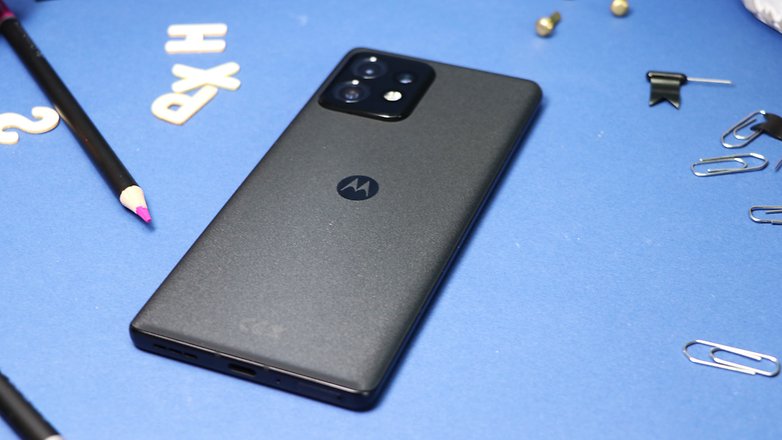
Motorola Edge+ (2023) software
Lenovo and Motorola deliver the Edge+ (2023) with Android 13. The in-house Moto My UX and Ready For as a mobile interface to a TV or PC monitor are included. The updates are in the solid Android midfield with three major Android iterations and support for four years of Google security updates. Thus, those who treat themselves to the device should at least still get Android 16.
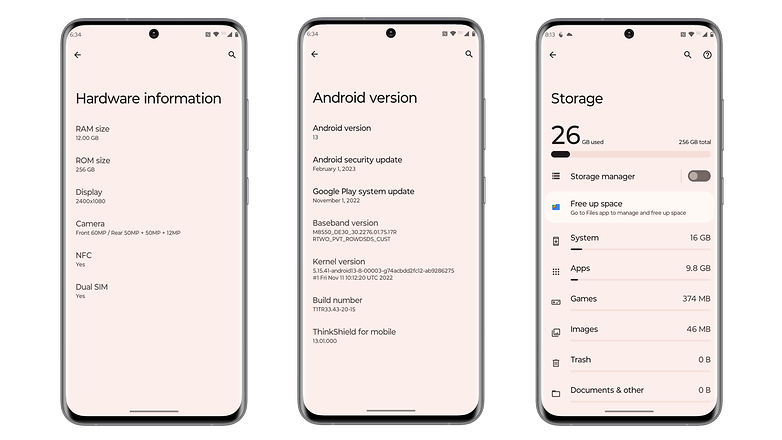
Unlike some competitors in this market segment, the Edge+ (2023) spares you in terms of bloatware – as long as you do not consider an extensive range of Google applications as bloatware.
At first glance, the user interface looks as clean as past “stock Android” models, however, I will go into more detail in the full review.
The in-house user interface including “Ready For” is very discreet and effective. The design modifications that are strongly based on Google’s “Material You” design are also very appealing. Motorola does not deny its former Google roots (2012 till 2014), which also suit the Edge+ (2023) well.
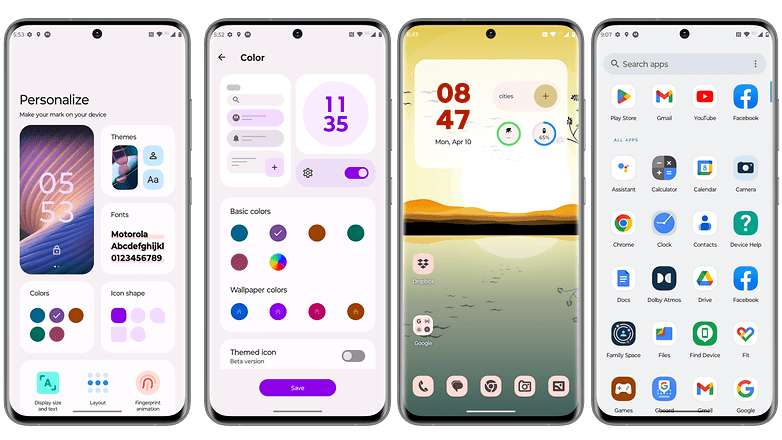 Moto My UX and Ready For are quite appealing and show Google’s roots. / © NextPit
Moto My UX and Ready For are quite appealing and show Google’s roots. / © NextPitMotorola Edge+ (2023) performance
Motorola combines the Snapdragon 8 Gen 2 with 12 GB of LPDDR5X RAM and 256 GB of UFS 4.0 storage and once again increases the performance compared with last year’s model.
The company does not show any weaknesses in connectivity either: Besides the Wi-Fi 6E functionality, the Edge+ (2023) is already listed as “Wi-Fi 7 ready”.
However, the first hardcore gaming sessions also show that the smartphone and the SoC (System on a Chip) manufactured in a 4 nm process are also quite ready to radiate a certain amount of heat. Thus, users who push the Edge+ (2023) really hard should also expect warm temperatures on the back. However, nothing near an uncomfortable level.
The performance is—no surprise here—beyond reproach. Only Samsung offers a bit faster processor with slight modifications to the same Snapdragon 8 Gen 2 CPU. Whether this really makes a difference in everyday use is open to question. However, we naturally wanted to know how big the differences are in detail in our first short test. Here is our overview of the benchmark results:
| Motorola Edge+ (2023) (Snapdragon 8 Gen 2) |
Samsung Galaxy S23 (SD 8 Gen 2 For Galaxy) |
Apple iPhone 14 (A15 Bionic) |
Xiaomi 13 (Snapdragon 8 Gen 2) |
|
|---|---|---|---|---|
| 3D Mark Wild Life | 8.062 | Too powerful | Too powerful | Too powerful |
| 3D Mark Wild Life Stress Test | Best loop: 12,125 Worst loop: 6,099 |
Best Loop: 11,049 Worst Loop: 6,169 |
Best Loop: 9,761 Worst loop: 8,321 |
Best loop: 12,914 Worst loop: 10,432 |
| Geekbench | Single: 1476 Multi: 4765 |
Single: 1537 Multi: 4807 |
Single: 1699 Multi: 4817 |
Single: 1481 Multi: 4310 |
At least in the 3D Mark Wild Life and Wild Life Stress Test, the Motorola Edge+ (2023) performed much better than the overclocked Samsung Galaxy S23. The Moto only had to admit defeat to the S23 in Geekbench 5. While the Motorola phone scores worse than the Xiaomi 13 in the single-core test, it can convince again with 4,765 points in the multi-core test. In summary, we can say that Motorola’s Edge+ (2023) is in the good midfield of the current flagships.

Motorola Edge+ (2023) camera
The camera is versatile: Besides the main snapper with 50 MP, a combined ultra-wide-angle macro sensor with 50 MP and the 12 MP telephoto cam complete the camera lineup.
In front, a selfie shooter with 60 MP is used, which almost looks excessive, at least on the spec sheet.
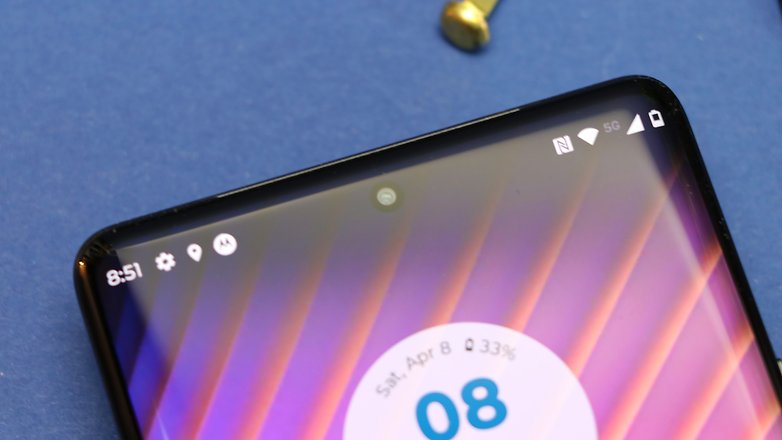
Motorola again relies on the “Quad Pixel” technology. The image sensor of the main camera grows to 1/15 inch. The pixel size is 1.0 μm, but doubles to 2.0 μm due to said “Quad Pixel” technology. Besides the 50 MP ultra-wide-angle camera, which also takes care of macro photos, a 12 MP portrait camera with an aperture of f/1.6 and a pixel size of 1.22 μm is also on board. 4K videos are possible with all sensors, and the main camera even provides you with 8K videos at 30 fps.
MaTT took the Motorola Edge+ (2023) to Germany’s “Tropical Island” over Easter thanks to its IP68 certification and took some test pictures for you. The first impression gives way to the prevailing euphoria. Don’t get me wrong: The Edge+ (2023) takes excellent daytime pictures. The macro shots are also pleasing. However, there are deductions in our short test for the 16x zoom, as well as the night shots.
For example, the shot in the “jungle” was taken at night. The colors in the background rather give the impression that these are daytime shots. In fact, a phenomenon that is now not unique to Motorola. Worse is the selfie, which was taken at the same time of day and does not deliver a brilliant performance despite the high resolution of the front camera. Photos on the other hand, like the one on Berlin’s TV tower around 6:00 p.m. or inside the shopping gallery, fared quite a bit better.
There is also no criticism for the pictures of flowers during the day in the standard setting as well as in macro mode. The 12 MP zoom shots diminish strongly with every further enlargement and only become “muddy” in the end.
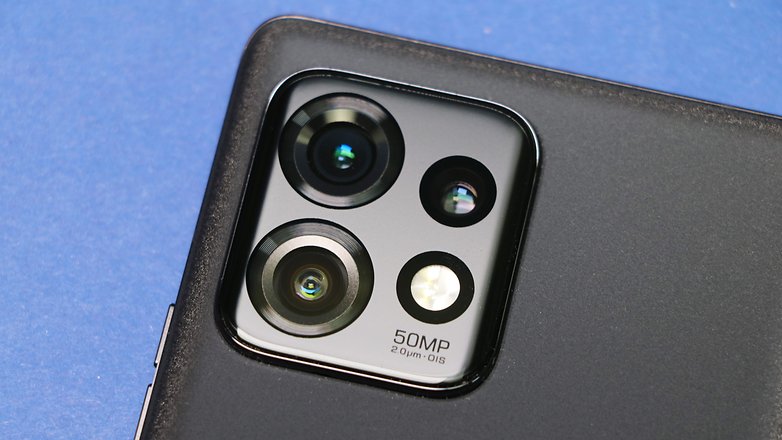
In return, the front-facing camera can deliver very good results in sufficient light. There is probably a general lack of quality in low-light photos. While the poor quality of the selfie is due to the small sensor, it is more likely to be a software setting in the main camera that could be fixed in the next update.
Motorola Edge+ (2023) battery
The battery has shrunk from 4,800 mAh to 4,600 mAh compared with Motorola’s Edge+ (2022). That is unfortunately worse compared to the competition like the Xiaomi 13 Pro we recently reviewed with 4,820 mAh or the Samsung Galaxy S23+ tested with 4,700 mAh. However, that does not matter since the charging power of 125 W has almost been doubled. In a quick test, I did not need 10 minutes to charge it from 50% battery to 100%.

When it comes to the battery, Motorola meets all the important criteria: The Edge+ (2023) not only charges really fast but also wirelessly with 15 W, and reverse charging is also possible.
In addition, the Lenovo subsidiary also packs the charger in the box. According to Motorola, six minutes at the socket are enough to use the phone for the whole day. Of course, this will vary from person to person.
One person with several e-mail accounts, heavy Internet consumption and regular exchange with his many social contacts has a different daily requirement than someone who only uses his smartphone for making calls. However, my first impressions showed a regular daily use without a power socket despite intensive camera use. And you already guessed it: More intensive experiences and test results will be coming in the final NextPit review!
Motorola Edge+ (2023) technical specifications
| Technical data | |
|---|---|
| Product | |
| Image |
 |
| MSRP | from 899,99 € (approx. $980) |
| Display | 6.67″, OLED |
| 2,400 x 1,080 px | |
| 165 Hz refresh rate | |
| SoC | Qualcomm Snapdragon 8 Gen 2 |
| Working memory | 12 GB RAM |
| Storage | 256 GB |
| Expandable memory? | – |
| OS | Android 13 |
| Camera | Main camera: 50 MP, f/1.8 aperture, OIS Ultra wide-angle/macro: 50 MP, f/2.2 aperture Telephoto: 12MP, f/1.6 aperture |
| Selfie camera | 60 MP, f/2.2 aperture |
| Battery | 4,600 mAh 125 W charging, charger included 15 W wireless charging 5 W wireless reverse charging |
| Connectivity | 5G / LTE / Wi-Fi 6E (Wi-Fi 7 ready) / Wi-Fi Direct / Bluetooth 5.3 / NFC |
| IP certification | IP68 |
| Colors | Interstellar Black, Lunar Blue |
| Dimensions and weight | 161.16 x 74 x 8.59 mm, 199 g |
Early Verdict
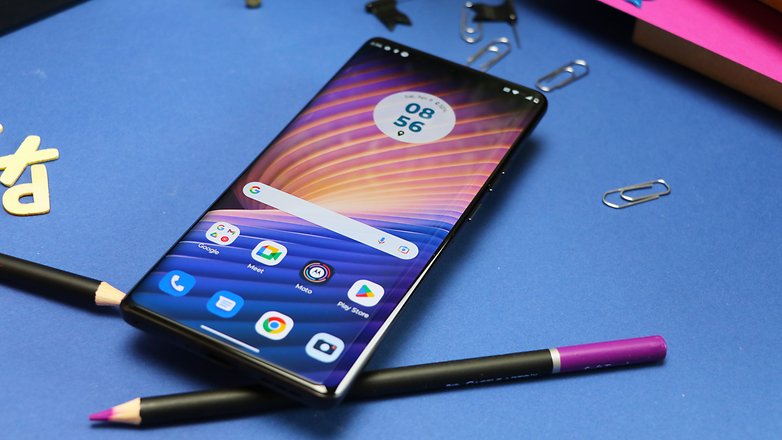
One thing quickly becomes clear after our short test: at a price of just under 900 Euros and a powerful Snapdragon 8 Gen 2, along with 12 GB RAM and 256 GB program storage, as well as a 6.7 OLED display with a refresh rate of 165 Hz, the Motorola Edge+ (2023) is a real contender among flagship smartphones.
The Lenovo subsidiary delivers across the board in terms of performance. If you look really hard for negative points, you will find them in the camera performance, which is not quite on the same level as the competition in night photography and the telephoto camera. The battery capacity should also be larger than its 4,600 mAh, but it is compensated again by the 125-W fast charging and 15-W wireless charging.

The update guarantee, a slim Android 13 without bloatware, and great “Moto My UX” and “Ready For” features make the Motorola Edge+ (2023) a real alternative in the flagship segment. Those who are still unsure should wait for our final review.
Motorola Edge+ (2023)
To device database

